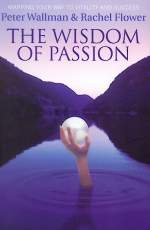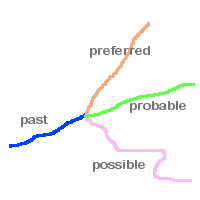I have been working with youth at risk (16 – 20 years old) who attend our year 11/12 schools in Tasmania. I imagine that one approach is not going to work with every student. In our new curriculum here there is going to be greater emphasis on pathway planning…each student has a teacher who acts as a “coach” and employs coaching processes to help them set goals and plan towards them. But the biggest problem for some of our students is having no goal or sense of direction or passion to begin with…. And such coaching processes do not really address this vacuum.
Finding my passion
 Rachel Flower, Dan Wallman's book The wisdom of passion : mapping your way to vitality and success focuses more on processes which help people get in tune with their inner wisdom or passion… so not a mental, scratch head “if I think hard enough about it, I’ll get the answer” sort of approach… but deeper, more contemplative… building up sense of self and emotional power… understanding and reading self.
Rachel Flower, Dan Wallman's book The wisdom of passion : mapping your way to vitality and success focuses more on processes which help people get in tune with their inner wisdom or passion… so not a mental, scratch head “if I think hard enough about it, I’ll get the answer” sort of approach… but deeper, more contemplative… building up sense of self and emotional power… understanding and reading self.
I found that I could gradually build some mindfulness and breathing into my “at risk” classes, but these students are not the sort to embrace something different…. particularly techniques likely to help them the most. I couldn’t just say, “hey, lets do a visualisation”…. whereas in classes where students are eager to learn they seem to be willing to try anything, and I have found visualisations really powerful in helping them tune into inner directions and purposes.
So with my at risk students I spent my time building up self esteem, success, service experiences, self awareness and emotional awareness and control… helping them move to a new self which could believe that they had a future. I found the book Reclaiming Youth at Risk (Brendtro, Brokenleg, van Bockern) very helpful.
I found meditating on each of my students important in seeing their energy blocks and being able to specifically create opportunities for them that might help create better flow... and thus open them up for learning. This meditative practice was essential in helping me see them deeply, rather than their very annoying behaviours and remind me of being fully present with  them in the moment... it required great attention and energy, but enabled me to tune into those turning moments... moments where their souls seem to listen and the words we say and our actions resonate at a deep level.
them in the moment... it required great attention and energy, but enabled me to tune into those turning moments... moments where their souls seem to listen and the words we say and our actions resonate at a deep level.
Many of these students were stuck in lower development stages because of awful things that had happened in their lives, so helping them heal and move on was a critical part of helping them get any sense of possibilities of who they were and where they were going.
If students are willing to try visualisations I have found Shakta Gwain's Creative Visualisations very useful, particularly one's which help students go to a special place and ask guidance of a wise old person, or are given gifts which they can interpret using dream symbology. Another one I have found successful is Three Wishes and also one's involving journeys.
For me, planning for the future is more than career planning; it is about understanding the relationships around oneself and how that might be your teacher. It is about recognizing issues to work on as well as talents and passions to pursue... it is really about whole of life, whole of self.
* * *
Aligning my actions with what I value
Many years ago, working with a mixed ability pastoral care group (1 hour per week) I developed a “thinking” approach based on working out “what I really value”. This was really powerful in helping students test whether their chosen career really aligned with what they valued and often it didn’t… particularly if they had been influenced by media and peer pressure. The process went like this:
1. whole class brainstorm about what they value in the following categories, writing up heaps of possibilities
- physical (eg. To be healthy, to be co-ordinated, to be full of energy)
- emotional ( eg. to be loved, to be in control of emotions)
- mental (eg. think logically, understand why things are…)
- spiritual/ idealistic (eg to feel connected to something bigger, to be free, to have a sense of purpose)
- Interpersonal ( eg. to get on well with my family, to have a meaningful relationship)
- Social/ecosystem/cosmos (eg. to be recognised by society, help save the planet)
(Doing this with the whole class enables to students to break out of their own perceptions and worldviews and see other possibilities, which they might not get if in one-to-one teacher interviews. The category approach helps delineate and other categories could be used just as well…. Often students hadn’t thought before about many of these.)
2. Choose from the lists 10 things you value (or create something new) and put in order from 1 to 10
3. Make a list of how you spend your time… but put into activities which consist of "things I value", and then "things that I don’t". Some things might not appear to have immediate value (like washing up the dishes) but when you reflect on it you might find aspects of it that you do value (when washing up, my sister drys and we actually have a good relaxing chat and a laugh.) Evaluate, and ask yourself are you doing now things that are congruent with what you value? How might you change this now? What sort of activities incorporate what you value? How do you feel when you are doing something you value? What proportion of your time is spent on things you value?
4. Homework: Practice doing things you value and be aware of how this makes you feel. Try new activities and see…. Can you come up with some criteria? Can you increase the proportion of what you value in your life? How does this affect your energy and your sense of purpose?
5. How might what you value change and grow over time? Is it static? Now under the headings career, recreation, relationships and life goals - write down what you think you might value in the short term (2 to 5 years) and long term (5 to 10 years). What types of careers might match what you value? (eg. a career where I am being creative … a career which helps someone or something... a career which is physical….) Does it matter if what you value changes or if your career changes?
* * * Mapping Preferred Futures
Mapping Preferred Futures
Another approach I have used with some success (this time a thinking/dreaming one) is using time lines where students firstly do a past line – from birth up until this moment… putting on it key aspects of their life, changes in self or circumstances, using symbols, pictures or words…. (eg I have seen some students put in bombs to represent D-day (divorce day)). Often very powerful stuff comes out of doing just this as students for the first time might see patterns emerging… experiences which reinforce a particular view of the world. (eg one girl wrote at different ages… my uncle left me, I moved and left my best friend, my parents divorced and father left me… when seeing this she said to me she felt afraid to commit to anything or anyone because she will be let down. She realised it was a defensive mechanism. A major revelation for her and helped her move into a more optimistic future.)
Once having done the past students then look into the future from this point on…. Draw three lines (or curves) – preferred, probable and possible. Now for each of these students should write down or draw key events they can imagine happening… try to see it occurring in their heads… see a little story, vision themselves into possibilities.
The possible line is a really important one for students to use their imaginations and break out of expected possibilities…. (They often see it as impossible!) They can have more than one of these possible lines. I have seen students write on their probable lines - get job, get married, have children…. While on the possible one – travel the world, be an explorer…. Etc. so the trick is to ask them how they can put their impossible dreams into their preferred future… something otherwise they might not dare.
(It is a real concern when students truncate the probable line because of expectation of suicide and life not worth living…. Which has occurred a couple of times with my classes.)
This technique is being used in Future Studies approaches with whole communities.
* * *
Who am I?
Another approach is using the enneagram and numerology … which are good to use with students who have had the more traditional “what am I going to be when I grow up?” activities all through highschool and are absolutely sick of them, and possibly don’t believe that they really do have a future or see where they fit into this world. It is a little different, slightly weird and exciting, and therefore attractive, and provides good reflective opportunities to ask is this like me or not…. Tying in with notions of temperaments. Here is a site for coaches wishing to use the enneagram.
No comments:
Post a Comment